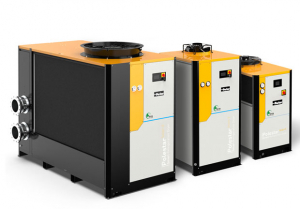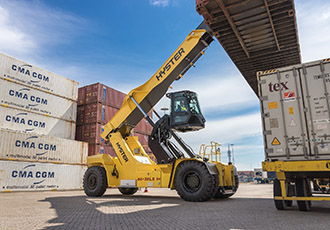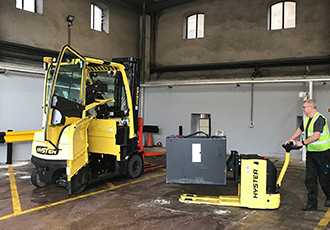What To Look For In A Goods Lift
2nd November 2010
Source:
Penny Hydraulics Ltd

There are many good reasons for installing a goods lift in a factory, warehouse or retail outlet. For some it is a matter of health and safety to avoid manual handling or carrying items up stairs. For others the aim is to open up previously inaccessible space on a first floor or mezzanine that can then be used for more efficient storage or additional sales space. Once the decision to install a lift has been made the choice of equipment remains and there are a number of potentially important considerations to take into account.
One of the most popular choices is a standard goods lift. These are often based on the same designs as passenger lifts which are then expected to accommodate pallets and other industrial loads. There is no doubt that lifts like this are versatile, especially for heavy loads, multi-floor or high lift applications, but there are drawbacks. The initial investment can be relatively high because of the structural changes that may be required in the building in addition to the capital costs of the equipment itself. Most standard goods lifts will require a floor pit to be dug out to accommodate essential parts of the mechanism and to allow the platform to recede and allow level access. This can be a problem if the building is leased and takes time and money but all of this can be justified if the lift will be in use for a reasonable period. But most industrial companies fully understand that situations change and at some indeterminate point in the future they might need to move to larger premises or reposition the lift to meet new business requirements. This is not easy if major structural changes are required.
Another potential issue with a standard goods lift is safety certification and compliance. The typical size of these lifts and the way they are used often means that they are capable of, and often used for, carrying people at the same time as the load. This means that the lift must be inspected and tested more frequently and to a much higher standard than other types of lift. Of course this is all proper and correct but it does add to the management and maintenance burden.
Scissor lifts are another popular choice. This tried and tested design is ideal for handling heavy loads between two floors but it too has its drawbacks. Most scissor lifts also require the excavation of a lift pit so all of the considerations already outlined still apply. Some may require certification for people carrying depending on how they are used. From an application point of view there may be some serious limitations. The way the mechanism operates means that, in general, this type of lift can only be used for handling items through a relatively short vertical distance without the legs becoming unduly long or the arrangement of components overly complex. Longer legs will inevitably mean larger platforms which is often impractical and adds to the costs. All of this means that the scissor lift is usually only good for handling items between two adjacent floors. If a second or third floor is added then an extra scissor lift may be required on each.
With standard goods and scissor lifts the complexity of the machinery can lead to unreliability. It certainly adds to the maintenance burden and associated costs. So what is the alternative?
Many companies are now turning to simpler goods lifts such as the Mezz Lift manufactured by Penny Hydraulics. Robust and built solely for industrial applications, this does not require a floor pit because it has a relatively thin platform which allows easy access and its hydraulic control equipment is typically mounted to the side of the installation. One of the principal limitations of other types of goods lift is therefore avoided which means that it can, if required, be relocated more easily and with little or no work to the building infrastructure. The Mezz Lift can also be installed outside the building.
From an application perspective devices such as the Mezz Lift allow users to match the configuration very closely to the job in hand. They can be supplied with bespoke platforms, perhaps to fit through an existing opening in a floor or in a purpose built self contained shaft. A wide variety of standard designs are available designed for the customer to meet their individual requirements. There are few restrictions on lifting height which means it can be installed, or extended, for multi-floor applications. The maximum working load is generally in the 250-500kg class which covers the vast majority of loads encountered in most industrial applications. Why waste money and install a larger capacity lift when it is not needed?
Robust construction and simple design combine to promote reliability and ease of use. Training is straightforward and maintenance issues are kept to a minimum, all of which helps to control overall life time costs.
One of the biggest advantages of a lift like the Mezz Lift is that it does not require the same level of safety certification as people-carrying lifts. However, like any other piece of lifting equipment, it is covered by the normal LOLER and PUWER regulations which means it must undergo a statutory thorough inspection at least once a year. These regulation are designed to ensure safety but are not as onerous as those covering lifts designed for people carrying.
Taking into account the pros and cons of the different types of available goods lift and matching the equipment to the application requirement really does help to narrow down the options so that a practical and affordable solution results.
Another potential issue with a standard goods lift is safety certification and compliance. The typical size of these lifts and the way they are used often means that they are capable of, and often used for, carrying people at the same time as the load. This means that the lift must be inspected and tested more frequently and to a much higher standard than other types of lift. Of course this is all proper and correct but it does add to the management and maintenance burden.
Scissor lifts are another popular choice. This tried and tested design is ideal for handling heavy loads between two floors but it too has its drawbacks. Most scissor lifts also require the excavation of a lift pit so all of the considerations already outlined still apply. Some may require certification for people carrying depending on how they are used. From an application point of view there may be some serious limitations. The way the mechanism operates means that, in general, this type of lift can only be used for handling items through a relatively short vertical distance without the legs becoming unduly long or the arrangement of components overly complex. Longer legs will inevitably mean larger platforms which is often impractical and adds to the costs. All of this means that the scissor lift is usually only good for handling items between two adjacent floors. If a second or third floor is added then an extra scissor lift may be required on each.
With standard goods and scissor lifts the complexity of the machinery can lead to unreliability. It certainly adds to the maintenance burden and associated costs. So what is the alternative?
Many companies are now turning to simpler goods lifts such as the Mezz Lift manufactured by Penny Hydraulics. Robust and built solely for industrial applications, this does not require a floor pit because it has a relatively thin platform which allows easy access and its hydraulic control equipment is typically mounted to the side of the installation. One of the principal limitations of other types of goods lift is therefore avoided which means that it can, if required, be relocated more easily and with little or no work to the building infrastructure. The Mezz Lift can also be installed outside the building.
From an application perspective devices such as the Mezz Lift allow users to match the configuration very closely to the job in hand. They can be supplied with bespoke platforms, perhaps to fit through an existing opening in a floor or in a purpose built self contained shaft. A wide variety of standard designs are available designed for the customer to meet their individual requirements. There are few restrictions on lifting height which means it can be installed, or extended, for multi-floor applications. The maximum working load is generally in the 250-500kg class which covers the vast majority of loads encountered in most industrial applications. Why waste money and install a larger capacity lift when it is not needed?
Robust construction and simple design combine to promote reliability and ease of use. Training is straightforward and maintenance issues are kept to a minimum, all of which helps to control overall life time costs.
One of the biggest advantages of a lift like the Mezz Lift is that it does not require the same level of safety certification as people-carrying lifts. However, like any other piece of lifting equipment, it is covered by the normal LOLER and PUWER regulations which means it must undergo a statutory thorough inspection at least once a year. These regulation are designed to ensure safety but are not as onerous as those covering lifts designed for people carrying.
Taking into account the pros and cons of the different types of available goods lift and matching the equipment to the application requirement really does help to narrow down the options so that a practical and affordable solution results.
Similar articles
More from Penny Hydraulics Ltd
- Highway safety improved as companies unite together 19th April 2017
- Chandelier maintenance swings into Birmingham Cathedral 22nd November 2016
- Engineers needed to make sure UK stays ahead of competitors 20th July 2016
- Penny Hydraulics new crane range makes light work of heavy lifting 12th March 2015




.jpg)







Write a comment
No comments